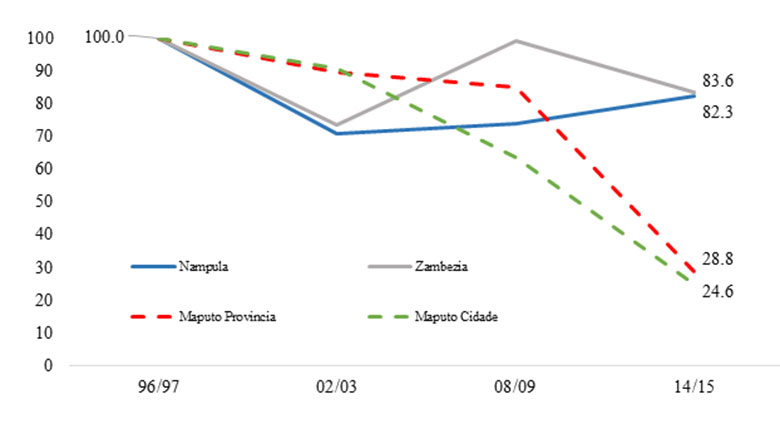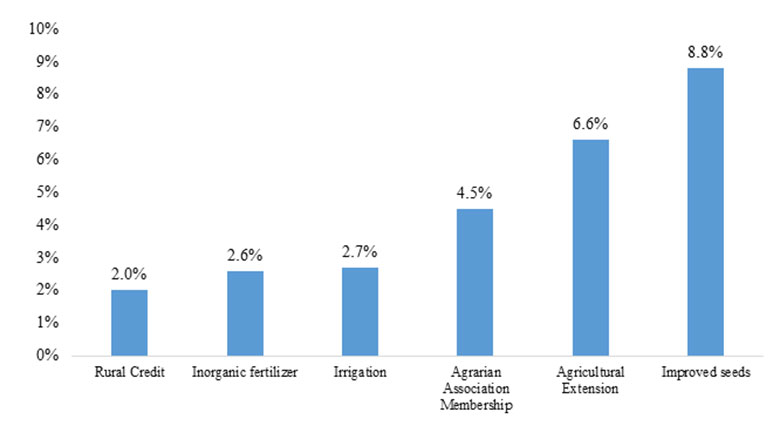News
Mozambique: Report discusses poverty trends and recommends way forward

Anemic poverty reduction reveals lack of social and economic inclusion
Between 1997 and 2009 for every percentage point of economic growth in Mozambique, poverty fell by only 0.26 percentage points in the country, roughly half of what is observed in the sub-Saharan Africa region, reveals the latest World Bank publication on poverty and its causes in Mozambique.
The publication titled “Accelerating Poverty Reduction in Mozambique: Challenges and Opportunities” also concludes that poverty has declined more slowly since 2003, having fallen by only 4 percentage points to reach 52 percent in 2009.
On the other hand, poverty reduction performance is uneven across regions of the country, with the central and northern regions showing disproportionately high poverty rates. In general, urban provinces tend to have lower poverty rates than rural provinces. Thus, the City of Maputo, for example, has the lowest levels of poverty in the country with 10 percent of the poor. At the other end of the distribution spectrum Zambezia province has poverty rates of 73 percent. Instead of shrinking like the rest of the country, poverty worsened in the 2003-2009 period in the provinces of Zambézia, Sofala, Manica and Gaza. These five provinces together accounted for approximately 70 percent of the poor in 2009, up from 59 percent in 2003. The provinces of Zambezia and Nampula together represented almost half of the country's poor in 2009 (48 percent), up from 42 Percent in 2003.
“The robust growth that the country has seen in recent times has mainly benefited the non-poor, signaling a weak inclusion in the country’s economic growth model,” said Mark Lundell, World Bank Director for Mozambique. “The country needs to focus on public policies and investments geared towards social and economic inclusion,” he added.
Mozambique has large levels of inequality. High levels of inequality tend to reduce the impact of economic growth on income growth for those at the bottom of the distribution scale. In other words, economic growth in Mozambique could have had a much greater impact on poverty reduction if its effects had not been affected by the increase in inequality over the same period. The absence of inclusive growth policies has affected the expansion of shared prosperity. To expand shared prosperity it would require a growing economy that brings more benefits to the lower echelons of the income distribution scale compared to the rest of the population.
The report also focuses on weak economic opportunities for the poor compared to the non-poor, as well as the issue of access (lack of) schooling as elements that contribute to the generational transmission of poverty among the poor. The report examines what is behind the high poverty rates in the central and northern provinces, concluding, among other things, that these provinces demonstrate low levels of return on household assets compared to other provinces, adding that if the return on household assets in relation to population assets had increased in the provinces of Nampula and Zambezia at the same pace as in the rest of the country, poverty would have reduced by about half in those two provinces.
Finally, the report recalls that while Mozambique has a huge potential for agriculture, which remains largely untapped, low productivity and limited growth in market-based agriculture are major contributors to weak poverty reduction. On the other hand, the effects of natural disasters on the economy as a whole are exacerbated by the weight of agriculture in the country’s GDP. For example, in the year 2000, cyclone Eline, which caused record levels of precipitation, caused costs estimated at 20 percent of GDP at the time.
Accelerating Poverty Reduction in Mozambique: Challenges and Opportunities
Poverty in Mozambique has fallen but not nearly quick enough, according to a new World Bank report. Official data shows that poverty fell from 69.7% in 1996 to 46.1% in 2015 but for each percentage point of economic growth between 1996 and 2009, poverty only reduced by 0.26 percentage points. This is nearly half as fast as what Sub-Saharan Africa has achieved relative to the same level of growth (0.5 percentage points).
The report notes that while poverty reductions have been modest, not everyone is benefitting equally. Inequality remains high and has reduced the potential for economic growth to generate significant gains in reducing poverty. More than two million Mozambicans could have been lifted out of poverty had the economic growth created between 1997 and 2009 been more equally shared.
Additional findings of the report:
-
Poverty remains much higher in rural areas and is becoming geographically concentrated in some provinces. Contrary to national trends, poverty increased in the 2000s in Zambezia, Sofala, Manica, and Gaza. Jointly with Nampula, these provinces account for 70% of the poor, up from 59% in 2002-03. Especially, Zambezia and Nampula are home to 38% of the population, yet nearly half of the poor live in these two provinces.
In the last 20 years poverty fell by over 70% in the south (Maputo City and Province) but by less than 20% in the north (Nampula and Zambezia)

Note: Y-axis is an index for the poverty rate (1996/97 = 100)
Source: Mozambican Ministry of Economy and Finance (2016)
-
Most of the population is disconnected from the growth process and low accessibility to and participation in markets explain up to 70% of the differences in changes in poverty rates between the lagging provinces and the rest of the country. Lack of access to basic services, ability to invest in human and physical capital, access to markets and economic opportunities constrains most of the population to contribute to and benefit from economic growth. In 2014-15, more than half of the people aged 20 to 30 years in the poorest provinces are illiterate. Only 8% and 4% of rural households have access to electricity and sanitation, respectively. Even when Mozambicans in the more isolated areas such as Nampula and Zambezia have managed to accumulate physical and human capital at a faster pace, they are unable to put them to good use and earn fair returns.
-
The vast majority of the population and almost all of the rural poor work in agriculture. Higher productivity and better connection to markets can lead to real improvements in poor people’s livelihoods. Agriculture’s potential to drive poverty reduction is dampened due to low productivity, (maize yields average one ton per hectare compared to 3.8 in South Africa and 2.2 in Malawi), low utilization of inputs and technology (less than 3% of farmers use fertilizers), and limited connectivity and commercialization (eight in 10 farmers are disconnected from reliable all-weather road networks and do not sell part of their production). A Mozambican farmer that employs fertilizers can profit from yields that are up to 40% higher compared to a farmer that doesn’t. Similarly, farmers that sell part of their produce, on average, record yields that are 25% higher relative to those engaged in subsistence farming.
Adoption of productivity enhancing technologies in the agricultural sector is low

-
Accelerating poverty reduction also requires protecting vulnerable populations from the effects of extreme weather. Three in four farmers in Mozambique report losing part of their crops, animals or other equipment due to climatic shocks. A child born in a place affected by severe floods, like the ones that hit the country in 2000, is more likely to be undernourished, drop out of school, and not participate in the labor market later in life than a child raised under normal weather conditions.




